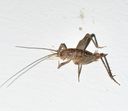Ceuthophilinae
Ceuthophilinae
Classification
- Phylum: Arthropoda
- Subphylum: Hexapoda
- Class: Insecta
- Order: Orthoptera
- Suborder: Ensifera
- Infraorder: Tettigoniidea
- Family: Rhaphidophoridae
- Subfamily: Ceuthophilinae
Pronunciation
How to pronounce Ceuthophilinae: //ˌsuːθəˈfɪlɪniː//
These audio files are automatically generated. While they are not always 100% accurate, they are a good starting point.
Images






Summary
The subfamily Ceuthophilinae encompasses cave crickets, camel crickets, and sand treaders, characterized by their wingless bodies and nocturnal behavior. They mostly inhabit damp environments like caves and are known for their large hind limbs and sensitive antennae.
Physical Characteristics
Most cave crickets have very large hind legs with "drumstick-shaped" femora and equally long, thin tibiae, and long, slender antennae. They are brownish in color and rather humpbacked in appearance, always wingless, and can reach up to 5 cm (2.0 in) long in body and 10 cm (3.9 in) for the legs.
Identification Tips
The fastigium of the head is triangular and is never divided into twinned prominences. All species have 5 or more pairs of movable spurs along the upper side of the hind tibiae.
Habitat
Most are found in forest environments, within caves, animal burrows, cellars, under stones or in wood, and similar environments. They are typically nocturnal and require cool, damp conditions.
Distribution
North America, with a worldwide distribution of the family Rhaphidophoridae.
Diet
Primarily scavengers, eating plant, animal, and fungi material.
Predators
Known predators include scorpions and birds like LeConte's thrasher (Toxostoma lecontei), particularly for sand treaders.
Ecosystem Role
They play a role in the ecosystem as decomposers, contributing to the breakdown of organic material.
Economic Impact
Generally considered a nuisance in buildings and homes due to their common indoor incursions in search of food and moisture.
Cultural Significance
Representations of cave crickets have been found in prehistoric caves, indicating their historical interaction with humans.
Health Concerns
While they are often mistaken for pests, they are completely harmless and pose no health risks to humans.
Misconceptions
Often confused with field crickets due to visual similarities, although they belong to different superfamilies and families.
Tags
- Ceuthophilinae
- camel crickets
- cave crickets
- sand treaders
- nocturnal insects
- decomposers